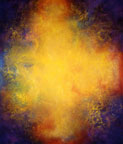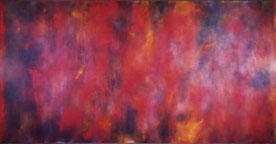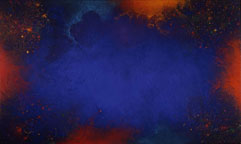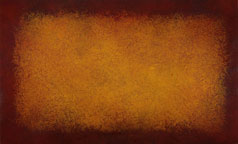Articles on Indian contemporary art by Swapna Vora
|
Natvar Bhavsar's cosmos July 18, 2008 (click on the small image for full screen image with captions.) This one thing, 'color' has myriad, noetic images in Bhavsar's work. His imposing work is like entering grand cathedrals, hue saturated monuments. This art is not a doorway to something, it is complete in itself. There are no direct religious overtones and it is essential to see, to actually view, his work. Copies and photographs do not convey his overwhelming experiments and great perception of color. No dilettante-like talk of tints, textures and wavelengths of light can show this skilled baring of energy and monumental, weighty creativity. Like Pollock, his paintings are impossible to copy and prints do not transmit their raw majesty. Of course there is the sheer delight of slight shadows, pleasurable turquoises, gemstone richness and startling neighboring of texture and pigment, a brush with life, in Bhavsar's work. There are gradual heaps of grains, fuzzy, soft focused stars, brilliant red and glowing, aubergine galaxies, encounters with velvet and ebony. Such a lot to see: gemstones and geodes, layer upon layer of pigments, subtle strokes that look like the cold tornados of space, starscapes and solar maps. The huge paintings doubtless overwhelm immediately with their sheer physical impact but the curlicues, slowly shifting irregularities, bars, curves, cells, and drifting, smoking oblongs too hold myriad secret stories. Colors have symbolic meanings, perhaps religious fevers, vanity or violent, disastrous implications, but here, soft borders, merging rows, flows, textures and detailed structures underpin clouds of light. His paintings are enormous, towering, and often almost alarming, like looking into the heart of the fires that forged universes: bubbling, roiling, and commanding. The small ones are equally thrilling, holding color filled narratives and novels. What a tale they could tell! Bhavsar's work is far removed from recognizable shapes, remote from daily symbols, but has definite, remembered feelings. "My first 5 years in America, I stayed here until '67. I was well integrated here. Janet was immediately my best friend and we traveled together, skied, and danced all over the world. Walked in the mountains! I am a good cook too! We are both doers, we work well together, a partnership of 43 years. Such a wonderful life! I would not barter any of it! My work is a process of finding out what color really is: learning is a process of finding out. And creativity is something different. Art challenges you, there are no requirements, but you need a strong character." There is no coldness or weary ennui in this work, no loss of enthusiasm and vitality, no decline in seriousness. He knows that his art involves pelagic depths and could not be done superficially.
"No, I do not do sculpture. I pursue just one cause. Why would I want to do anything else when I love this so much? I want to paint for a thousand years, even such a long period is not enough for such an unfathomable involvement and need. I have started, started. This offering I can give in spiritual terms." Bhavsar's family originates from the legendary deity Parshuram: however there are no direct religious symbols in his work. "I am very impressed as to how religion, art and nature have combined. We have this one chance to be as close to the truth as possible. Symbolism is the last thing for me, I cannot follow accepted rules which would mean diluting personal knowledge and beliefs. Symbols convey very popular meanings. These are less popular with me. For me, symbols show accepted implications." Speaking of Indian dance and the absolute body, he said that Indian sculpture is lyrical poetry in stone. He said, "To extract the abstract, to have the very essence, the essential part, throw away anything not useful. For example, contemporary painters, like Raza, Kinkar, Ramkumar, did have a semi-realistic approach following cubism. They adopted it, adapted it, adapted to it and threw away whatever was useless. Then they moved away from the Bengal School of realism. They moved away from realism. The works of Rothko, Pollock, Nauman are very, very charged, a powerful experience and brought me back to my experience with color in India: color issued as vehicles to carry, to bring in the aesthetic experience. This is the door to the abstract experience. Realism is not so deep. When we view art, we go and remember it. It is not the realism but the power, which is abstract, that moves us – how it is painted and what it does to one." The Japanese took to his work immediately and he remains loved there. In India, he was honored and called Vishva Gurjari but his work not yet been shown there. Until corporations started hosting culture, the merchant class used to cultivate art and today again people are buying hungrily. However, a major retrospective on Bhavsar in India is long overdue. He has been invited obviously, but a corporation needs to support this major endeavor. Thousands of his paintings are with top American corporations and in mainstream international collections. Some are in renowned locations like the Boston Museum, and in New York's Guggenheim Museum and the Metropolitan Museum of Art.
|
Articles on Indian contemporary art by Swapna Vora











